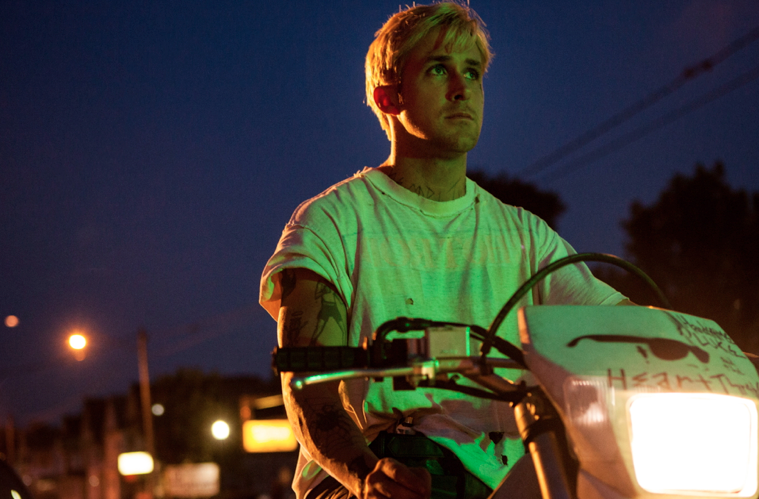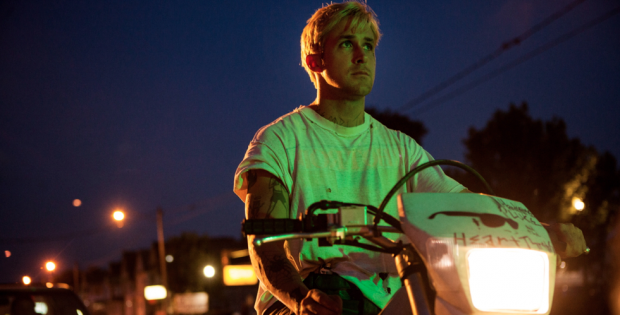
Entering the room with a smile, while blasting Prince from an iPhone held up in his left hand, Ryan Gosling was seemingly making the best of a long press day for The Place Beyond the Pines. The multigenerational family/crime tale marks his second project with director Derek Cianfrance, following their devastating 2010 drama Blue Valentine.
When it comes to his character of Luke, we’ll let the actor explain his background; “He’s in like a motorcycle version of a boy band in the early 90s doing some low-rent carnival circuit. It doesn’t get worse than that and he’s kind of like a melting pot of every masculine cliche — tattoos, muscles, guns — it’s a joke.” Getting to his character’s motivations, Gosling continues, “He’s presented with this child that he didn’t know he had and it’s like the mirror is held up to him and he realizes that he’s not a man at all because none of those things make you a man and sort of a completely surface person without any depth.”
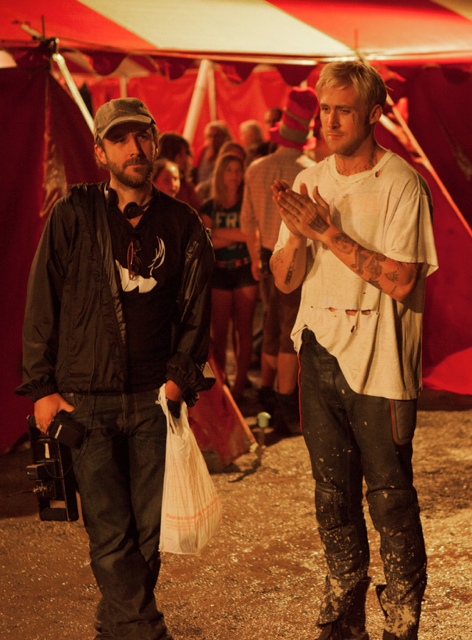 Gosling said his character thought the ideas of manhood was “fighting or the willingness to be violent or threatening,” but did not know “what was really required from him, which was just to be present and just to be there. It’s all he really had to do.” The Pines actor says his simple definition of what it takes to be a man is, “Doing what you say you are going to do.”
Gosling said his character thought the ideas of manhood was “fighting or the willingness to be violent or threatening,” but did not know “what was really required from him, which was just to be present and just to be there. It’s all he really had to do.” The Pines actor says his simple definition of what it takes to be a man is, “Doing what you say you are going to do.”
However for Luke, Gosling says, “He feels a tremendous amount of shame and in the same way that he over romanticized himself and created his own mythology, he has the same romantic ideas of turning it around and starts robbing banks which is equally as unthought-out as his face tattoo.” Removed from his character, Gosling echoed a similar feeling of shame regarding the tattoo.
The actor says, “The plan was to create a portrait of somebody that has lived a lifetime of making bad decision, so we asked, ‘what’s the most bad tattoos you’ve ever seen?” But after getting his face tattoo made up, he admits, “it was just too much and it was overkill.” Confronting his director, Gosling says, “I was like I can’t do this. I look ridiculous. It’s going to ruin the movie.” But Cianfrance made him stick to his actions, saying, “Well, I’m sure that’s how people with face tattoos feel. They regret them. This movie is about consequences and now you have to pay the price.”
To get prepared for the actions that cause these eventual consequences, Gosling spent a month in the upstate New York town of Schenectady. “It’s a great place. It’s not very big, but I loved it,” the actor exclaimed. “I’m from this small town in Canada called Cornwall and it’s very similar to Schenectady, so I felt very much at home.”
While spending time in the town, The Place Beyond the Pines actor visited real-life bank robbers, who explained their procedure. “In reality, in bank training they are told to give the money up if you even ask for it. So the truth is all the guns and yelling is not really necessary.” Gosling laughs, “I’m not promoting or advocating this, but in theory you could just go, ‘Yeah, I’d like to have all of that please. Just all of it.’ And they have to do it, they’d be happy to give it to you. You have to give away with it.”
The man who was going to let Gosling get away with it was his director. Speaking on the incarnation of the project, the director explains, “In 2007 I was at Ryan’s agent’s house and we were having dinner and we were preparing Blue Valentine, talking all about it and I asked him, ‘You’ve done so much in your life. What haven’t you done? What have you always wanted to do?’ And he says, ‘Well, I always wanted to rob a bank but I’ve always been too scared of jail.’ And I said, ‘Well that’s funny. I’ve been writing a movie about a bank robber. It’s called The Place Beyond the Pines. Have you given any thought on how you would do it?'”
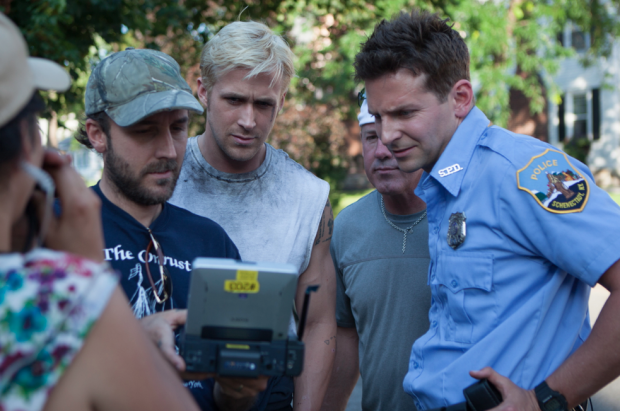
Indeed, Gosling had had the illusion for sometime, absorbed by hearing the story of a man in Tel Aviv, “who had been doing it for years with great result, on a motorcycle with a box truck parked in an alley.” Cianfrance told him, “That’s crazy. That’s exactly what we’ve written into the script.’ And it was one one of those times when I realized destiny — that we were meant to make movies together.” Cianfrance gave him on offer he couldn’t refuse, saying, “I’ll make your dreams come true and you won’t even have to go to jail, only for a day when we’re shooting it.”
When it comes to their working relationship, Gosling had nothing but high praise for the director. “It’s hard to talk about performance without talking about Derek, because so much of what we do is teed up by him and the environment he creates and the style in which he works,” Gosling says. “One of the great things about Derek is he never writes these emotional marks into the script. So you never come into the scene to feel this pressure that you have to hit this high note. If they happen, they happen naturally.”
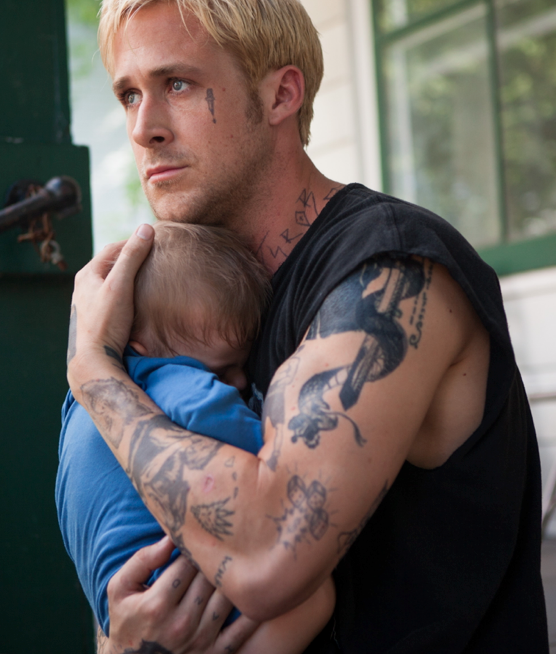 He continues, “I think it’s hard to explain — it’s even hard for me to understand and I’m watching it, how much effort goes in for Derek to make something that feels so effortless. This movie is like the directorial equivalent of a bank heist. It just took so much planning to pull it off and what I admire it so much about is his filmmaking is invisible, even though its cinematic. It’s a very hard thing to do. It’s very unself-conscious and he had a lot of guts to structure the film this way.”
He continues, “I think it’s hard to explain — it’s even hard for me to understand and I’m watching it, how much effort goes in for Derek to make something that feels so effortless. This movie is like the directorial equivalent of a bank heist. It just took so much planning to pull it off and what I admire it so much about is his filmmaking is invisible, even though its cinematic. It’s a very hard thing to do. It’s very unself-conscious and he had a lot of guts to structure the film this way.”
It was not an easy road though, as Gosling talks of the opposition, “A lot of people to told him not to, people were very, very adamant that he not do it this way. He’s just like the most stubborn person I’ve ever known. He will not change it and to me what’s amazing is that it has all the elements of a traditional heist film, a crime thriller, family drama and all these different genres. It’s deconstructed and laid out in a way that allows the audience to have a different experience in that kind of a movie, which is very hard to do.”
While Cianfrance had his own struggles with getting his vision on the screen, Gosling opened about his own personal conflicts of expectations. “I’m not very good at knowing what people want,” the actor admits. “I don’t have that talent, so the best I can do is to make films that resonate with me and then see what happens. It’s not something that I feel like I can predict and maybe if I’ve tried to do that I’m instantly humbled, so I’ll stay out of that.”
Gosling will soon get a chance to see if audiences resonate with his style, as he’s stepping behind the camera with his directorial debut, the fantasy drama How to Catch a Monster. Set to star Saoirse Ronan, Christina Hendricks, Matt Smith and Pines actors Eva Mendes and Ben Mendelsohn, Gosling discussed his desire to reteam with collaborators. “You spend so much time when you do a movie just tiptoeing around peoples’ process and getting to know one another,” Gosling explains. “I think you waste a lot of time being polite.” When it comes to working with Mendes, Goslings says, “making a movie has a dreamlike quality. These characters in the film knew each other in a different life, as did Eva and I. It added an authenticity to the connection.” A similar connection is found with Cianfrance, as Gosling says, “we had a shorthand and we’re able to be brutally honest with eachother and hopefully if we keep working together we’ll grow.”
 Cianfrance isn’t the only director that Gosling has formed a collaboration with, as his Drive follow-up with Nicolas Winding Refn, titled Only God Forgives, is set to debut this summer after a potential Cannes bow. Set in the Thailand crime underworld, Gosling says, “It’s way more violent [than Drive]. Well, I wouldn’t say violent — it’s way more extreme. I feel like they’re so wildly different, but it’s been another great collaboration and another one I hope to continue.”
Cianfrance isn’t the only director that Gosling has formed a collaboration with, as his Drive follow-up with Nicolas Winding Refn, titled Only God Forgives, is set to debut this summer after a potential Cannes bow. Set in the Thailand crime underworld, Gosling says, “It’s way more violent [than Drive]. Well, I wouldn’t say violent — it’s way more extreme. I feel like they’re so wildly different, but it’s been another great collaboration and another one I hope to continue.”
His only other film in the can is a currently untitled work from Terrence Malick, which he shot last year with Christian Bale, Natalie Portman, Michael Fassbender, Rooney Mara and more. When asked what he gleaned from working with the director, and others, Gosling says, “You learn from all these guys, but you also learn that it’s not just a style that you can adopt. They have a vision and a strong point of view. They have a filter by which they send everything through and it’s unique to each of them and the idea is to try and admire that but not emulate it, because you can only be yourself. And it sounds cheesy, but I think when it comes to filmmaking, there’s really nowhere to hide. You can tell so much about somebody by the films that they make. It’s only as I approach this that I start to realize exactly how much of the filmmaker you can see in their films.”
The Place Beyond the Pines hits theaters on March 29th.

